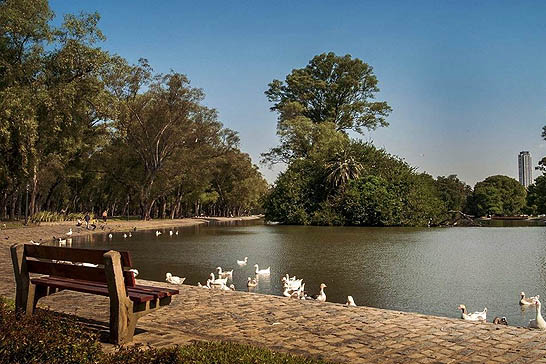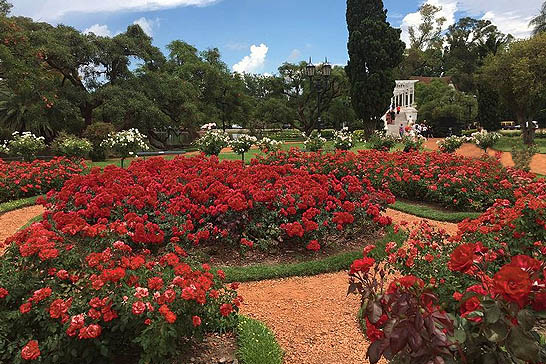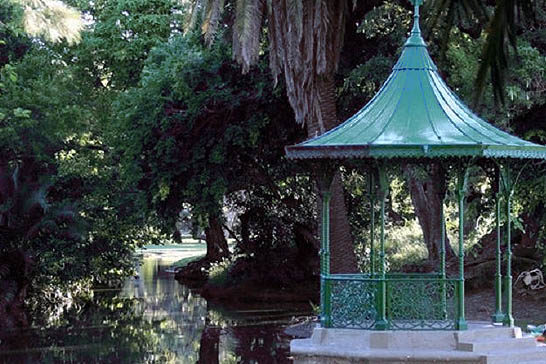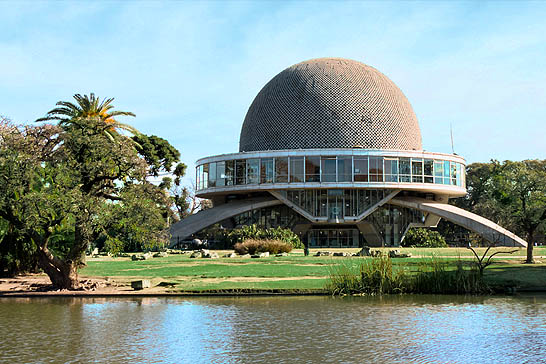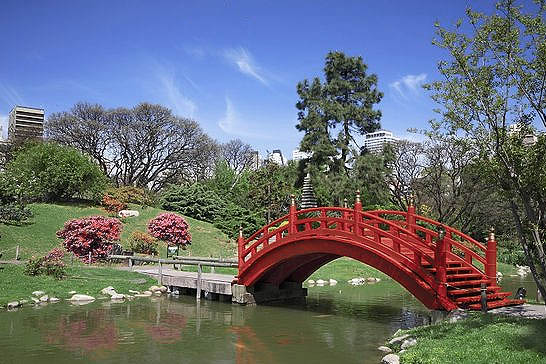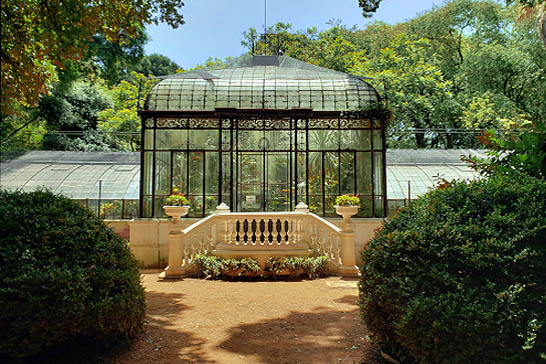3 de Febrero Park stands out as the most iconic green area in the city. Encompassing 370 hectares, it features extensive open-access spaces such as squares, promenades, and the Rose Garden. It also includes privately used areas, such as the Japanese Garden or the Golf Club. The Palermo Hippodrome is also nestled within this park. Let's discover its most beautiful spaces!
The Rose Garden
The Rose Garden is situated on Av. Presidente Pedro Montt. Covering almost 4 hectares and accessible to all, it boasts 8,000 roses of 93 distinct species. It's a daily magnet for tourists and locals, inviting them to stroll amid the varied hues of rose bushes. Additionally, visitors can explore the lake featuring the iconic white bridge, the pergola, a collection of poets' busts, the Andalusian patio, and an amphitheater.
The white bridge, also known as the Bridge of Lovers, spans a section of the lake and serves as one of the primary entrances to the Rose Garden. Continuing along the path, visitors encounter the Pergola adorned with wisteria, followed by the Poets' Busts Walk and the Andalusian Patio, a gazebo with a fountain, surrounded by benches, and adorned with decorative majolica.
Squares and Lakes
The Rose Garden is encircled by numerous plazas (squares), each adorned with pathways, wooded areas, and sculptures. In Plaza Sicilia, Lake Ocampo stands as a reflective water body enveloped by trees, an ancient bridge, and a charming kiosk. The Arab Republic of Egypt Square hosts water-based amusements for children along with charming gazebos. Adjacent is the Islamic Republic of Iran Square, distinguished by its famed Persian column (a gift from the last Shah of Persia) and the presence of the Persian lion.
Planetarium
In the vicinity of the rose garden, within Plaza Benjamín Gould, stands the Galileo-Galilei planetarium. Shaped like the planet Saturn, this building is dedicated to scientific-astronomical knowledge. It shares space with another water feature that is part of an extensive landscaped area, ideal for outdoor enjoyment.
Ecopark
The ecopark is the former city zoo. Inaugurated by President Domingo F. Sarmiento in 1874, it had 52 buildings mirroring the animals' habitats. After closing in 2016, it underwent transformation to prioritize animal welfare. Today, the Ecopark promotes biodiversity conservation through education and offers walks to admire its fountains, historic buildings, and local fauna.
Japanese Garden
Established in 1967 to honor Japanese royalty (current emperors), it's a large garden featuring oriental trees, a nursery offering famous bonsai, a cultural center, and a central lake with traditional bridges for feeding koi fish. An oasis of oriental calm in Buenos Aires.
Carlos Thays Botanical Garden
Established in 1898 and named after French landscaper Carlos Thays, it houses over 6,000 plant species across 7 hectares. Notable native species include tipa, salteño cedar, ibirá-puitá, quebracho colorado, and aguaribay.
Featuring 3 distinct gardens, a botanical library, 5 greenhouses (the largest in Art Nouveau style, awarded at the 1900 Paris Universal Exhibition), an herbarium, and an English mansion hosting temporary art exhibits and workshops.
Its pathways invite visitors to unwind amidst trees and sculptures, finding a spot to enjoy the fresh air and tranquility offered by nature in Buenos Aires.
You'll discover captivatingly beautiful spaces frequented by people seeking strolls, sports, or leisure with friends, much like other parks in the city. In our 'Recoleta and Palermo' tour, you'll personally explore the enchanting Bosques de Palermo. For more information, visit the Tours section on this website.
Additionally, you'll find details about the Ecological Reserve and Parque Lezama in this link: https://n9.cl/pg98l , both competing in popularity with Bosques de Palermo, awaiting exploration in our 'A Different Buenos Aires' tour.
Have you visited any of these spaces? Or both? Which one did you prefer? We look forward to your comments.
Unveiling the hidden charms of Bosques de Palermo (Palermo woods)
Despite being widely recognized as Bosques de Palermo, the actual name of this park collection is Tres de Febrero. Let's explore several of these green spaces and their unique charm, appealing to both locals and tourists.
